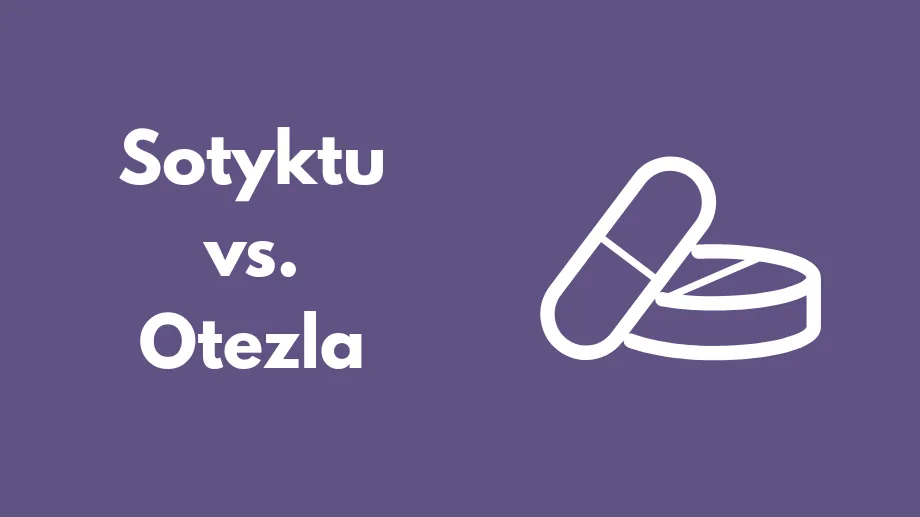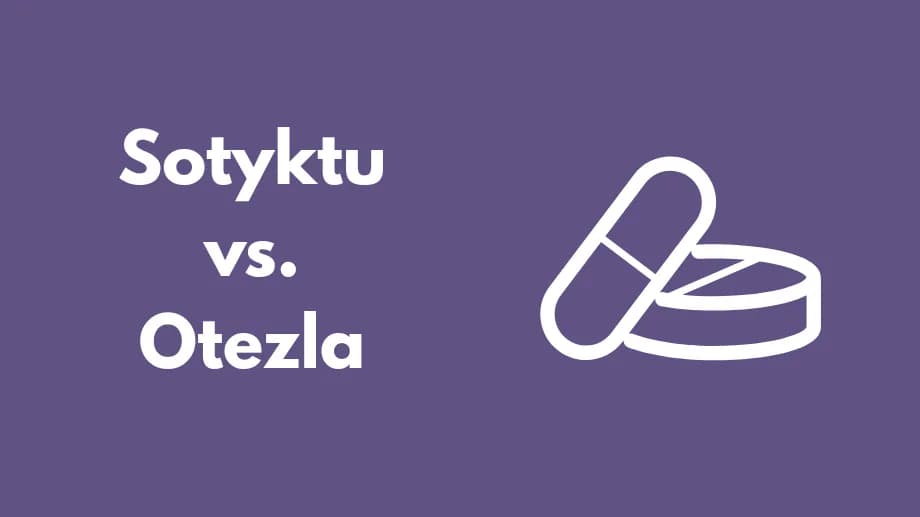Sotyktu vs. Otezla

Otezla and Sotyktu are both oral treatments for moderate-to-severe plaque psoriasis. Otezla is taken twice daily, while Sotyktu is taken once daily. Clinical trials comparing the two found that Sotyktu provides greater skin clearance.
Clinical Trial Results
Trials used the Psoriasis Area and Severity Index (PASI) to measure improvements:
- After 24 weeks, 42% of patients on Sotyktu achieved PASI 90 (90% reduction in symptoms) versus 22% on Otezla.
- In another study, 32% on Sotyktu reached PASI 90 compared to 20% on Otezla.
Scalp psoriasis results after 16 weeks:
- 70% of patients on Sotyktu had clear or almost clear scalp.
- 39% of patients on Otezla achieved the same result.
Read on for details on how each drug works, side effects, and more.
Otezla and Sotyktu FAQs
What is Otezla?
Otezla contains apremilast, a phosphodiesterase 4 (PDE4) inhibitor that reduces inflammation. It is approved for:
- Active psoriatic arthritis
- Plaque psoriasis in adults requiring systemic therapy or phototherapy
- Oral ulcers in Behçet’s disease
What is Sotyktu?
Sotyktu contains deucravacitinib, a tyrosine kinase 2 (TYK2) inhibitor that blocks inflammatory signaling. It is approved for moderate-to-severe plaque psoriasis in adults eligible for systemic or phototherapy. Approval is based on the POETYK PSO-1 and PSO-2 trials, where Sotyktu outperformed placebo and Otezla.
Side Effects of Otezla
Common side effects:
- Diarrhea
- Nausea
- Upper respiratory tract infection
- Headache
Other possible effects:
- Weight loss
- Vomiting
- Joint, back, or stomach pain
- Indigestion
- Insomnia
- Fatigue
Rare severe effects:
- Life-threatening allergic reactions
- Severe gastrointestinal issues
- Worsening depression or suicidal thoughts
Side Effects of Sotyktu
Common side effects:
- Upper respiratory infections
- Herpes simplex (genital or cold sores)
- Mouth ulcers
- Folliculitis (swollen hair follicles)
- Acne
Rare severe effects:
- Life-threatening allergic reactions
- Serious infections including tuberculosis or hepatitis reactivation
- Rhabdomyolysis
- Increased lymphoma risk
Warnings and Precautions for Otezla
- Do not use if allergic to apremilast.
- Mood disorders, depression monitoring.
- Kidney disease may require dose adjustment.
- Avoid in pregnancy or breastfeeding without medical advice.
Warnings and Precautions for Sotyktu
- Do not use if allergic to deucravacitinib.
- Monitor liver and kidney function.
- High triglycerides may require monitoring.
- Avoid live vaccines during treatment.
- Avoid in pregnancy or breastfeeding without advice.
- Not studied in rheumatoid arthritis; avoid JAK inhibitor risks.
Drug Interactions with Otezla
Avoid coadministration with strong CYP450 inducers:
- Phenytoin
- Rifampin
- Carbamazepine
- Phenobarbital
Drug Interactions with Sotyktu
No specific drug interactions listed, but always inform your provider of all medications.
Can You Take Both Together?
No formal studies have evaluated their combined use. Both increase infection risk, so concurrent use is not recommended without close monitoring.
Effectiveness of Sotyktu
In phase 3 trials:
- After 16 weeks, ~50% achieved clear or almost clear skin (sPGA 0/1) versus ~9% on placebo.
- After 16 weeks, ~53% achieved PASI 75 versus ~9% on placebo.
- 70% maintained clear or almost clear skin at 24 weeks and through 52 weeks.
- At 112 weeks, 82% achieved PASI 75 and 55% PASI 90; 67% had sPGA 0/1.
Onset of Action for Sotyktu
Symptom improvement often appears by 16 weeks, with continued benefits over time.
Cost of Sotyktu
Wholesale acquisition cost is over $6,000 for a 30-day supply, or up to $75,000 per year. Actual out-of-pocket cost depends on insurance coverage.
Related Medications
- Rituxan (rituximab)
- Xeljanz XR (tofacitinib)
- Rinvoq (upadacitinib)
- Actemra (tocilizumab)
- Orencia (abatacept)
